Dispersion Analysis of Twist-Symmetric Dielectric Waveguides
Abstract
1. Introduction
2. Results and Discussion
2.1. Eigenmode Solver
2.2. Frequency Domain Simulation of a Truncated Structure
2.3. Multimode Transfer-Matrix Method (MMTMM)
3. Conclusions
Author Contributions
Funding
Institutional Review Board Statement
Informed Consent Statement
Data Availability Statement
Acknowledgments
Conflicts of Interest
References
- Crepeau, P.J.; McIsaac, P.R. Consequences of symmetry in periodic structures. Proc. IEEE 1964, 52, 33–43. [Google Scholar] [CrossRef]
- Mittra, R.; Laxpati, S. Propagation in a wave guide with Glide refection symmetry. Can. J. Phys. 1965, 43, 353–372. [Google Scholar] [CrossRef]
- Kieburtz, R.; Impagliazzo, J. Multimode propagation on radiating traveling-wave structures with glide-symmetric excitation. IEEE Trans. Antennas Propag. 1970, 18, 3–7. [Google Scholar] [CrossRef]
- Quevedo-Teruel, O.; Ebrahimpouri, M.; Kehn, M.N.M. Ultrawideband metasurface lenses based on off-shifted opposite layers. IEEE Antennas Wireless Propag. Lett. 2016, 15, 484–487. [Google Scholar] [CrossRef]
- Quevedo-Teruel, O.; Valerio, G.; Sipus, Z.; Rajo-Iglesias, E. Periodic structures with higher symmetries: Their applications in electromagnetic devices. IEEE Microw. Mag. 2020, 21, 36–49. [Google Scholar] [CrossRef]
- Quevedo-Teruel, O.; Chen, Q.; Mesa, F.; Fonseca, N.J.G.; Valerio, G. On the Benefits of Glide Symmetries for Microwave Devices. IEEE J. Microw. 2021, 1, 457–469. [Google Scholar] [CrossRef]
- Hessel, A.; Chen, M.H.; Li, R.C.M.; Oliner, A.A. Propagation in periodically loaded waveguides with higher symmetries. Proc. IEEE 1973, 61, 183–195. [Google Scholar] [CrossRef]
- Valerio, G.; Ghasemifard, F.; Sipus, Z.; Quevedo-Teruel, O. Glide-symmetric all-metal holey metasurfaces for low-dispersive artificial materials: Modeling and properties. IEEE Trans. Microw. Theory Tech. 2018, 66, 3210–3223. [Google Scholar] [CrossRef]
- Quevedo-Teruel, O.; Miao, J.; Mattsson, M.; Algaba-Brazalez, A.; Johansson, M.; Manholm, L. Glide-symmetric fully metallic Luneburg lens for 5G communications at Ka-band. IEEE Antennas Wireless Propag. Lett. 2018, 17, 1588–1592. [Google Scholar] [CrossRef]
- Bantavis, P.; Gonzalez, C.G.; Sauleau, R.; Goussetis, G.; Tubau, S.; Legay, H. Broadband graded index Gutman lens with a wide field of view utilizing artificial dielectrics: A design methodology. Opt. Express 2020, 28, 14648–14661. [Google Scholar] [CrossRef]
- Fan, F.; Cai, M.; Zhang, J.; Yan, Z.; Wu, J. Wideband low-profile Luneburg lens based on a glide-symmetric metasurface. IEEE Access 2020, 8, 85698–85705. [Google Scholar] [CrossRef]
- Chen, Q.; Giusti, F.; Valerio, G.; Mesa, F.; Quevedo-Teruel, O. Anisotropic glide-symmetric substrate-integrated-holey metasurface for a compressed ultrawideband Luneburg lens. Appl. Phys. Lett. 2021, 118, 084102. [Google Scholar] [CrossRef]
- Ebrahimpouri, M.; Quevedo-Teruel, O.; Rajo-Iglesias, E. Design guidelines for gap waveguide technology based on glide-symmetric holey structures. IEEE Microw. Wireless Compon. Lett. 2017, 27, 542–544. [Google Scholar] [CrossRef]
- Chen, Q.; Mesa, F.; Yin, X.; Quevedo-Teruel, O. Accurate Characterization and Design Guidelines of Glide-Symmetric Holey EBG. IEEE Trans. Microw. Theory Tech. 2020, 68, 4984–4994. [Google Scholar] [CrossRef]
- Monje-Real, A.; Fonseca, N.J.G.; Zetterstrom, O.; Pucci, E.; Quevedo-Teruel, O. Holey glide-symmetric filters for 5G at millimeter-wave frequencies. IEEE Microw. Wireless Compon. Lett. 2020, 30, 31–34. [Google Scholar] [CrossRef]
- Palomares-Caballero, A.; Alex-Amor, A.; Padilla, P.; Valenzuela-Valdes, J.F. Dispersion and filtering properties of rectangular waveguides loaded with holey structures. IEEE Trans. Microw. Theory Tech. 2020, 68, 5132–5144. [Google Scholar] [CrossRef]
- Ebrahimpouri, M.; Rajo-Iglesias, E.; Sipus, Z.; Quevedo-Teruel, O. Cost-effective gap waveguide technology based on glide-symmetric holey EBG structures. IEEE Trans. Microw. Theory Tech. 2018, 66, 927–934. [Google Scholar] [CrossRef]
- Vosoogh, A.; Zirath, H.; He, Z.S. Novel air-filled waveguide transmission line based on multilayer thin metal plates. IEEE Trans. Terahertz Sci. Technol. 2019, 9, 282–290. [Google Scholar] [CrossRef]
- Ebrahimpouri, M.; Algaba Brazalez, A.; Manholm, L.; Quevedo-Teruel, O. Using glide-symmetric holes to reduce leakage between waveguide flanges. IEEE Microw. Wireless Compon. Lett. 2018, 28, 473–475. [Google Scholar] [CrossRef]
- He, Z.S.; An, S.; Liu, J.; Jin, C. Variable high precision wide D-band phase shifter. IEEE Access 2020, 8, 140438–140444. [Google Scholar] [CrossRef]
- Ebrahimpouri, M.; Quevedo-Teruel, O. Ultrawideband anisotropic glide-symmetric metasurfaces. IEEE Antennas Wireless Propag. Lett. 2019, 18, 1547–1551. [Google Scholar] [CrossRef]
- Ebrahimpouri, M.; Herran, L.F.; Quevedo-Teruel, O. Wide-angle impedance matching using glide-symmetric metasurfaces. IEEE Microw. Wireless Compon. Lett. 2020, 30, 8–11. [Google Scholar] [CrossRef]
- Dahlberg, O.; Ghasemifard, F.; Valerio, G.; Quevedo-Teruel, O. Propagation characteristics of periodic structures possessing twist and polar glide symmetries. EPJ Appl. Metamat. 2019, 6. [Google Scholar] [CrossRef]
- Dahlberg, O.; Mitchel-Thomas, R.C.; Quevedo-Teruel, O. Reducing the dispersion of periodic structures with twist and polar glide symmetries. Sci. Rep. 2017, 7, 1–6. [Google Scholar] [CrossRef]
- Ghasemifard, F.; Norgren, M.; Quevedo-Teruel, O. Twist and polar glide symmetries: An additional degree of freedom to control the propagation characteristics of periodic structures. Sci. Rep. 2018, 8, 11266. [Google Scholar] [CrossRef] [PubMed]
- Quevedo-Teruel, O.; Dahlberg, O.; Valerio, G. Propagation in waveguides with transversal twist-symmetric holey metallic plates. IEEE Microw. Wireless Compon. Lett. 2018, 28, 858–860. [Google Scholar] [CrossRef]
- Dahlberg, O.; Valerio, G.; Mesa, F.; Ghasemifard, F.; Norgren, M.; Quevedo-Teruel, O. Dispersion analysis of periodically loaded transmission lines with twist symmetry using the mode-matching technique. Appl. Sci. 2020, 10, 5990. [Google Scholar] [CrossRef]
- Bastioli, S.; Snyder, R.V. Nonresonating modes do it better!: Exploiting additional modes in conjunction with operating modes to design better quality filters. IEEE Microw. Mag. 2021, 22, 20–45. [Google Scholar] [CrossRef]
- Palomares-Caballero, A.; Padilla, P.; Alex-Amor, A.; Valenzuela-Valdés, J.; Quevedo-Teruel, O. Twist and glide symmetries for helix antenna design and miniaturization. Symmetry 2019, 11, 349. [Google Scholar] [CrossRef]
- Dahlberg, O.; Valerio, G.; Quevedo-Teruel, O. Fully metallic flat lens based on locally twist-symmetric array of complementary split-ring resonators. Symmetry 2019, 11, 581. [Google Scholar] [CrossRef]
- Wei, Z.; Cao, Y.; Fan, Y.; Yu, X.; Li, H. Broadband polarization transformation via enhanced asymmetric transmission through arrays of twisted complementary split-ring resonators. Appl. Phys. Lett. 2011, 99, 221907. [Google Scholar] [CrossRef]
- Alex-Amor, A.; Mesa, F.; Palomares-Caballero, Á.; Molero, C.; Padilla, P. Exploring the potentials of the multi-modal equivalent circuit approach for stacks of 2-D aperture arrays. IEEE Trans. Antennas Propag. Early access. [CrossRef]
- Zhao, Y.; Belkin, M.A.; Alù, A. Twisted optical metamaterials for planarized ultrathin broadband circular polarizers. Nat. Commun. 2012, 3. [Google Scholar] [CrossRef] [PubMed]
- Zhao, Y.; Askarpour, A.N.; Sun, L.; Shi, J.; Li, X.; Alù, A. Chirality detection of enantiomers using twisted optical metamaterials. Nat. Commun. 2017, 8. [Google Scholar] [CrossRef] [PubMed]
- Sipus, Z.; Bosiljevac, M. Modeling of glide-symmetric dielectric structures. Symmetry 2019, 11, 805. [Google Scholar] [CrossRef]
- Chiral Photonics. Available online: https://chiralphotonics.com/ (accessed on 1 June 2021).
- Kopp, V.I.; Genack, A.Z. Double-helix chiral fibers. Opt. Lett. 2003, 28, 1876–1878. [Google Scholar] [CrossRef] [PubMed]
- Sensiper, S. Electromagnetic Wave Propagation on Helical Structures (A Review and Survey of Recent Progress). Proc. IRE 1955, 43, 149–161. [Google Scholar] [CrossRef]
- Malekabadi, A.; Charlebois, S.A.; Deslandes, D.; Boone, F. High-Resistivity Silicon Dielectric Ribbon Waveguide for Single-Mode Low-Loss Propagation at F/G-Bands. IEEE Trans. Terahertz Sci. Technol. 2014, 4, 447–453. [Google Scholar] [CrossRef]
- Lugo, D.C.; Ramirez, R.A.; Wang, J.; Weller, T.M. Multilayer Dielectric End-Fire Antenna with Enhanced Gain. IEEE Antennas Wireless Propag. Lett. 2018, 17, 2213–2217. [Google Scholar] [CrossRef]
- Lugo, D.C.; Wang, J.; Weller, T.M. Analytical and Experimental Study of Multilayer Dielectric Rod Waveguides. IEEE Trans. Microw. Theory Tech. 2021, 69, 2088–2097. [Google Scholar] [CrossRef]
- Keiser, G. Optical Fiber Communications, 4th ed.; McGraw-Hill: New York, NY, USA, 2011. [Google Scholar]
- Ericsson, A.; Lundgren, J.; Sjöberg, D. Experimental characterization of circular polarization selective structures using linearly single-polarized antennas. IEEE Trans. Antennas Propag. 2017, 65, 4239–4249. [Google Scholar] [CrossRef]
- Mesa, F.; Valerio, G.; Rodriguez-Berral, R.; Quevedo-Teruel, O. Simulation-assisted efficient computation of the dispersion diagram of periodic structures: A comprehensive overview with applications to filters, leaky-wave antennas and metasurfaces. IEEE Antennas Propag. Mag. 2020. [Google Scholar] [CrossRef]
- Bagheriasl, M.; Valerio, G. Bloch analysis of electromagnetic waves in twist-symmetric lines. Symmetry 2019, 11, 620. [Google Scholar] [CrossRef]
- Valerio, G.; Paulotto, S.; Baccarelli, P.; Burghignoli, P.; Galli, A. Accurate Bloch analysis of 1-D periodic lines through the simulation of truncated structures. IEEE Trans. Antennas Propag. 2011, 59, 2188–2195. [Google Scholar] [CrossRef]
- Bagheriasl, M.; Quevedo-Teruel, O.; Valerio, G. Bloch analysis of artificial lines and surfaces exhibiting glide symmetry. IEEE Trans. Microw. Theory Tech. 2019, 67, 2618–2628. [Google Scholar] [CrossRef]
- Mesa, F.; Rodriguez-Berral, R.; Medina, F. On the computation of the dispersion diagram of symmetric one-dimensionally periodic structures. Symmetry 2018, 10, 307. [Google Scholar] [CrossRef]
- Premix Preperm Website. Available online: https://www.preperm.com/ (accessed on 31 May 2021).

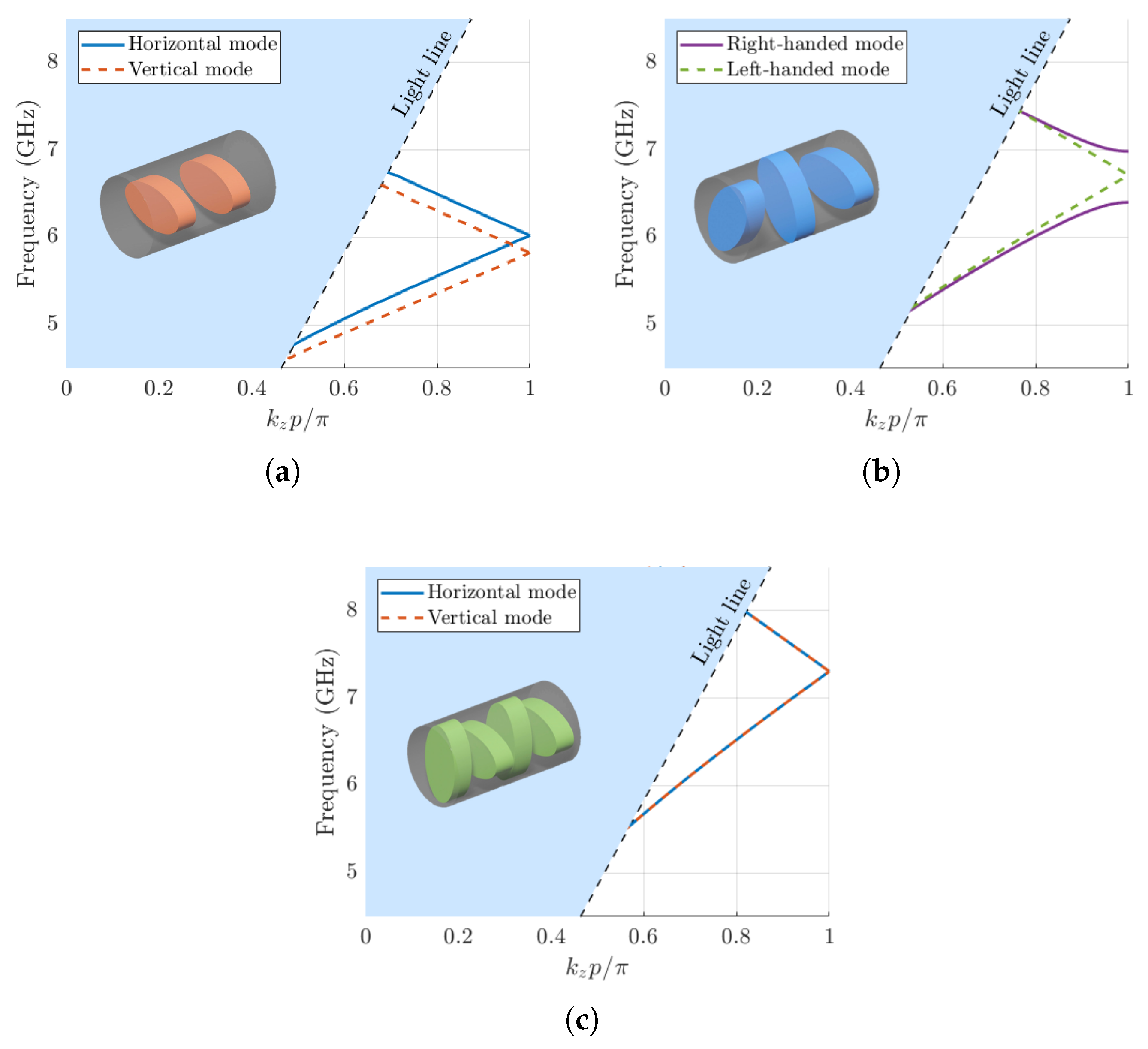
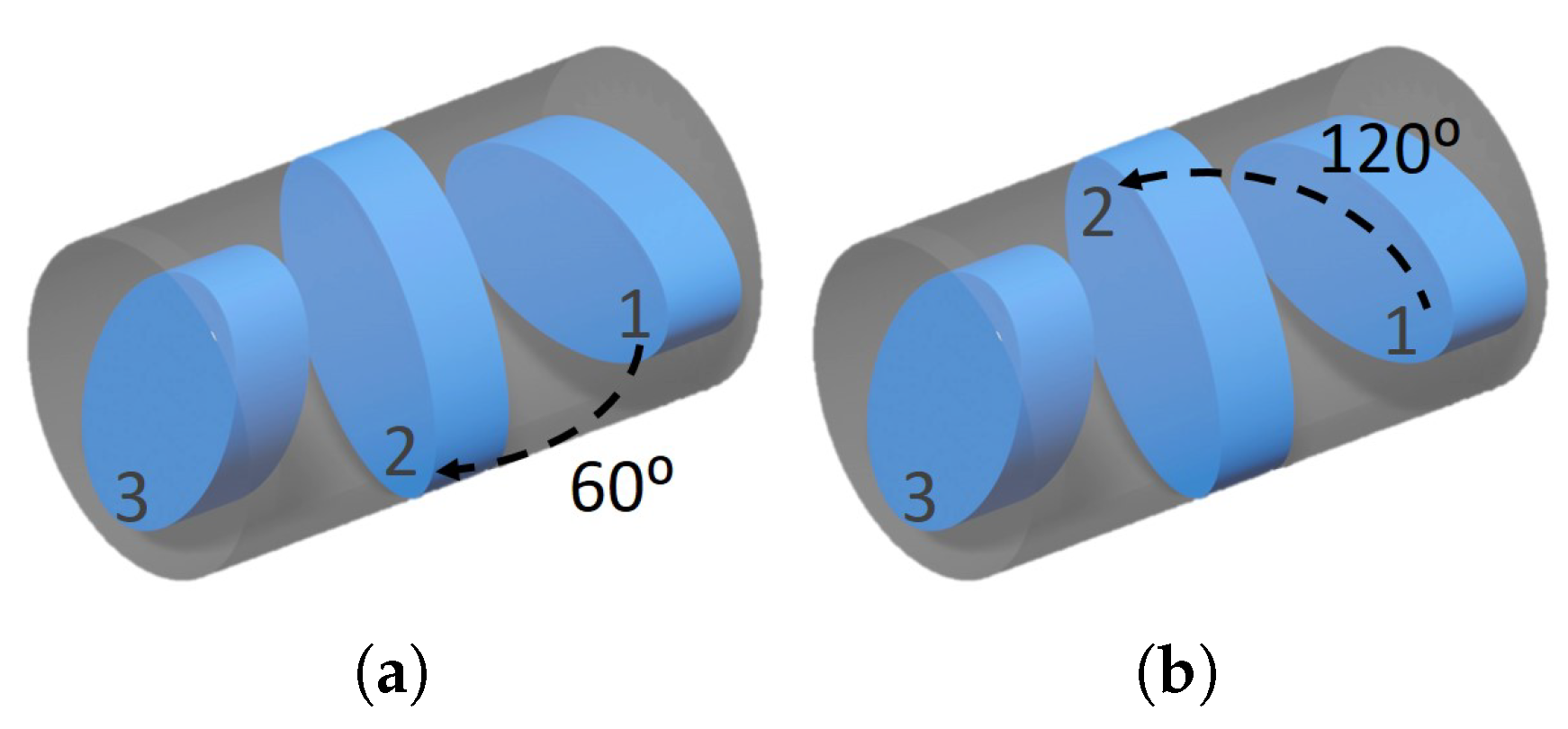
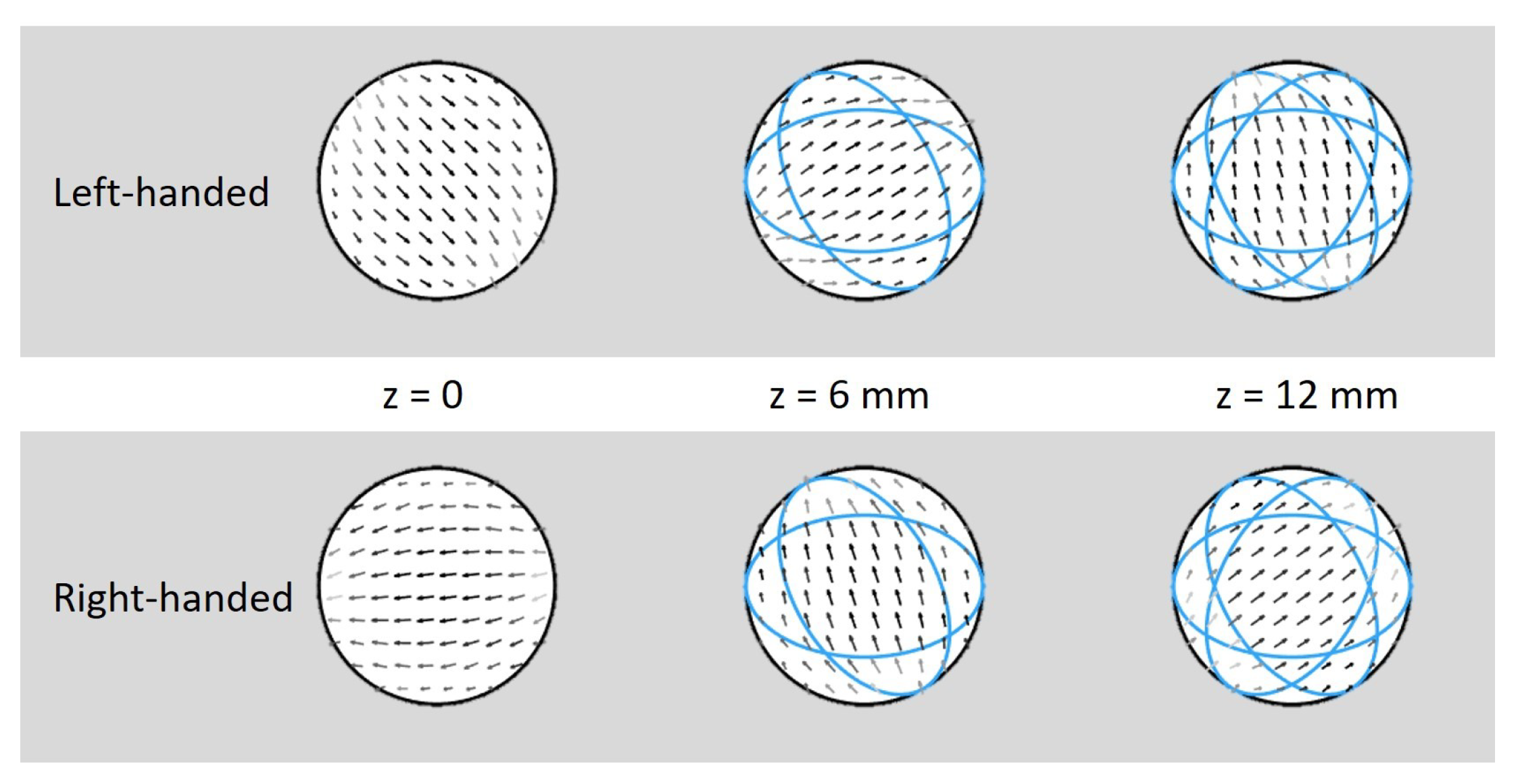
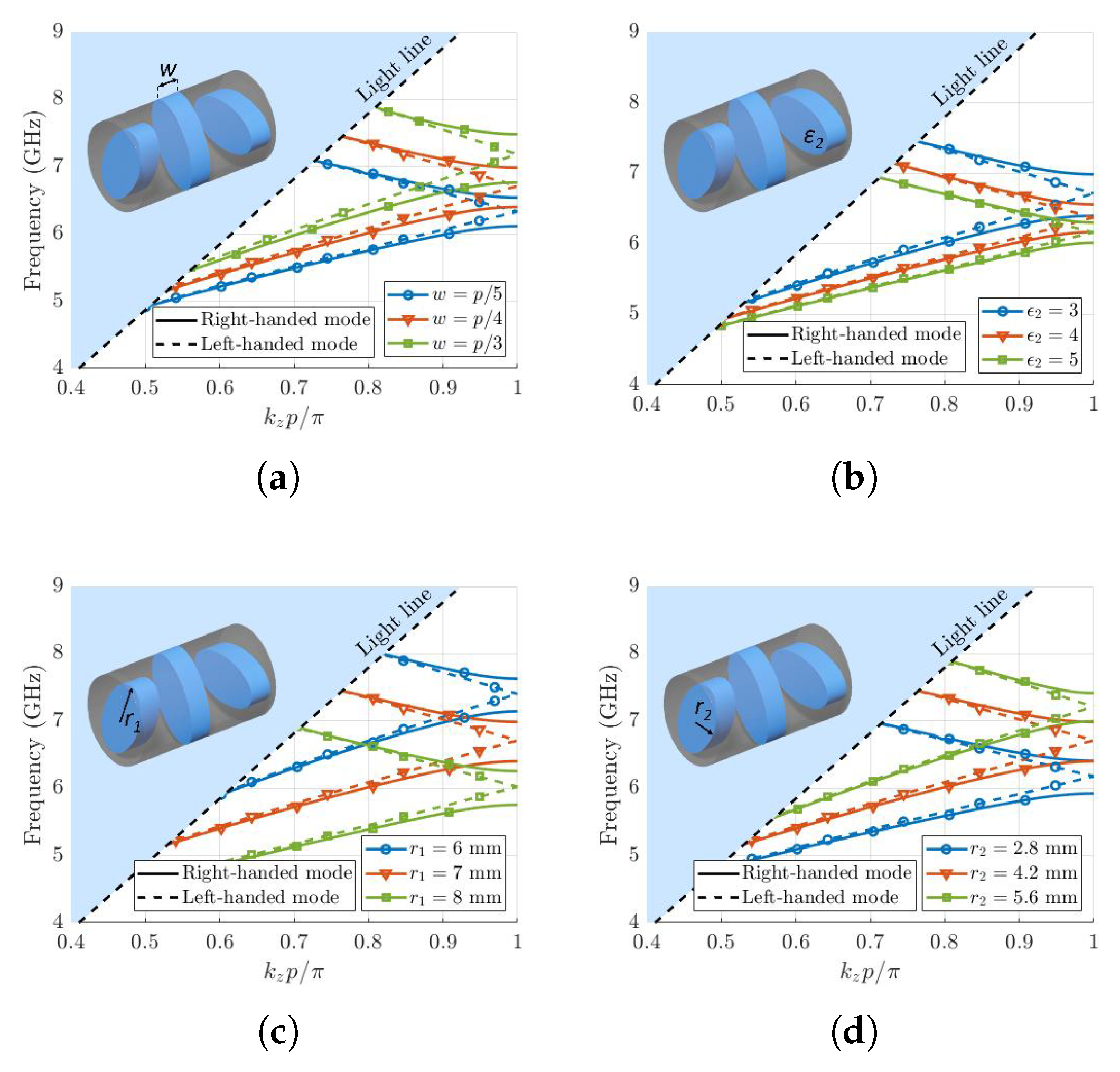
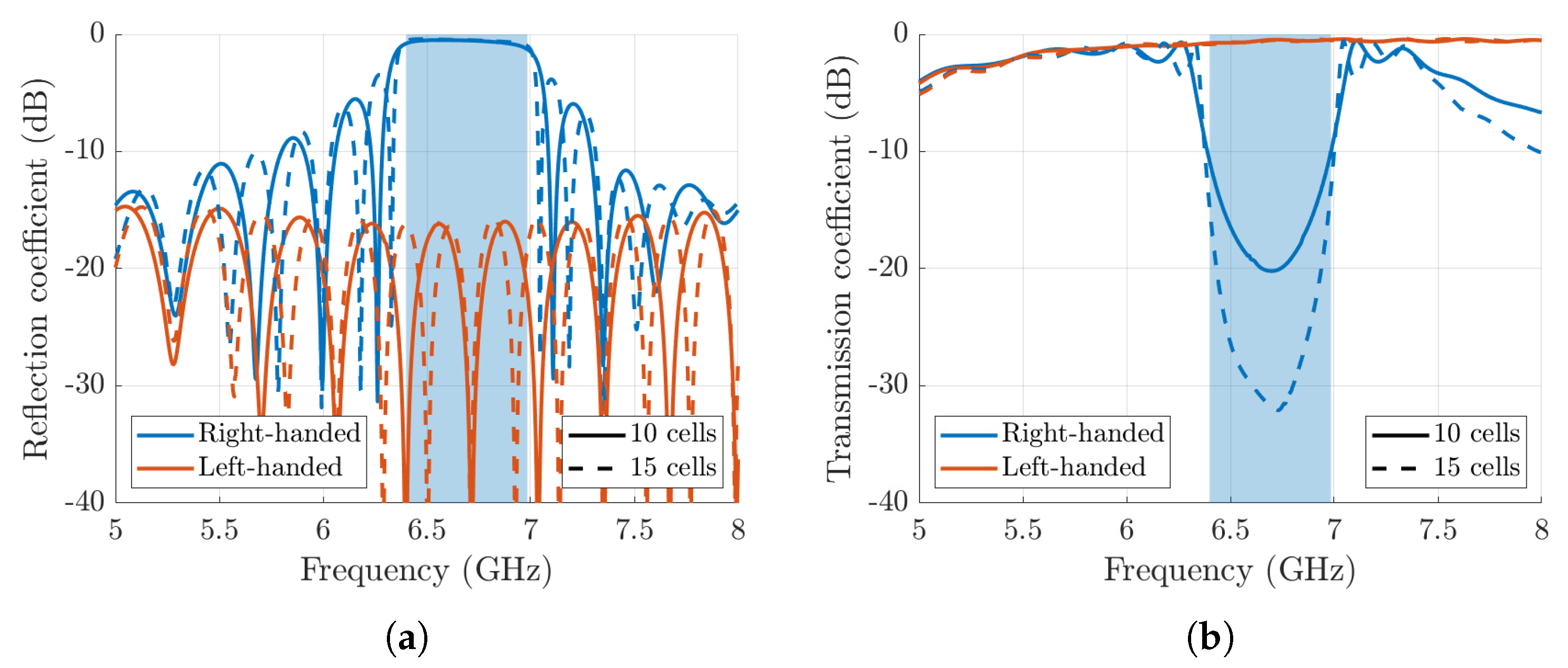
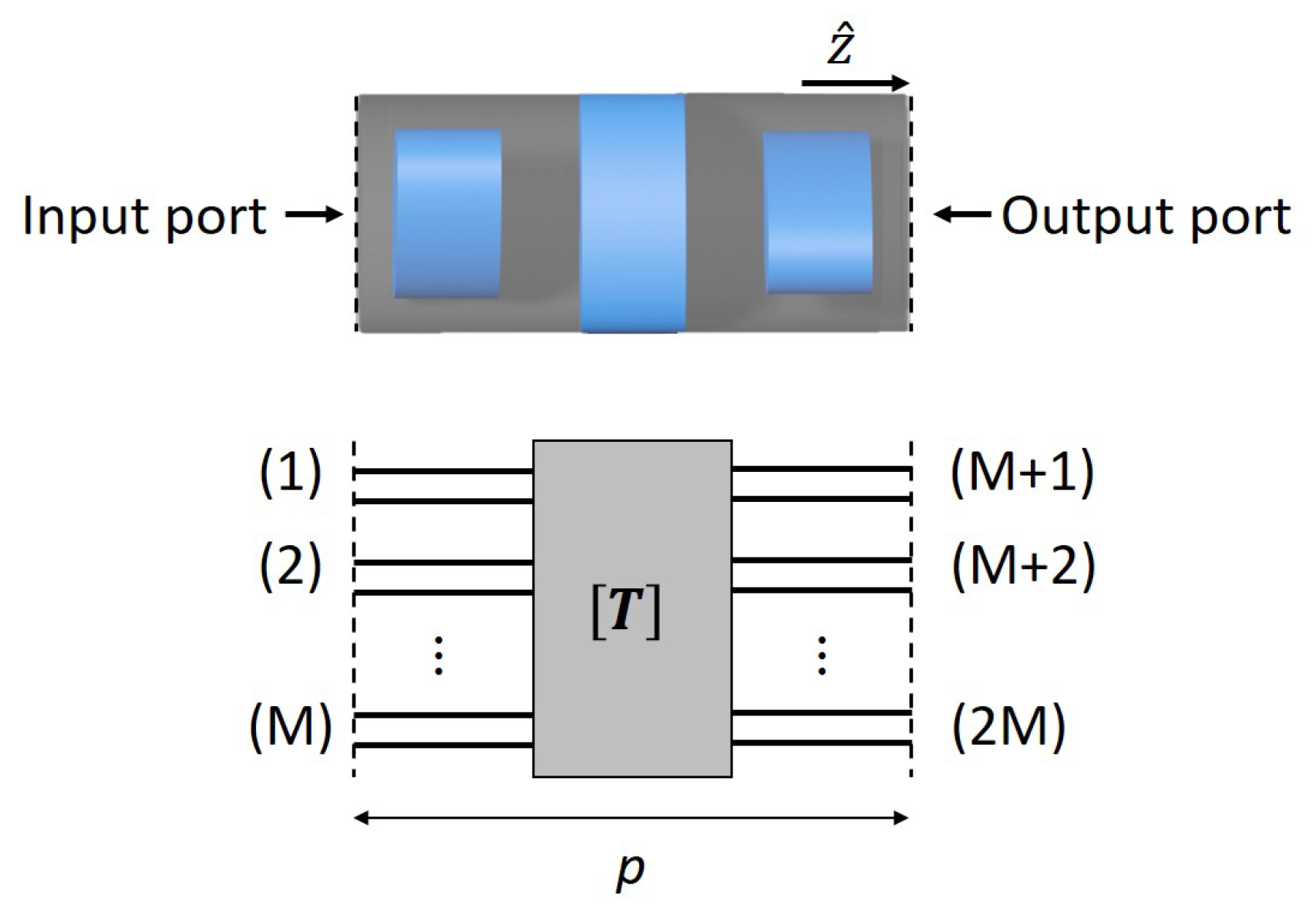
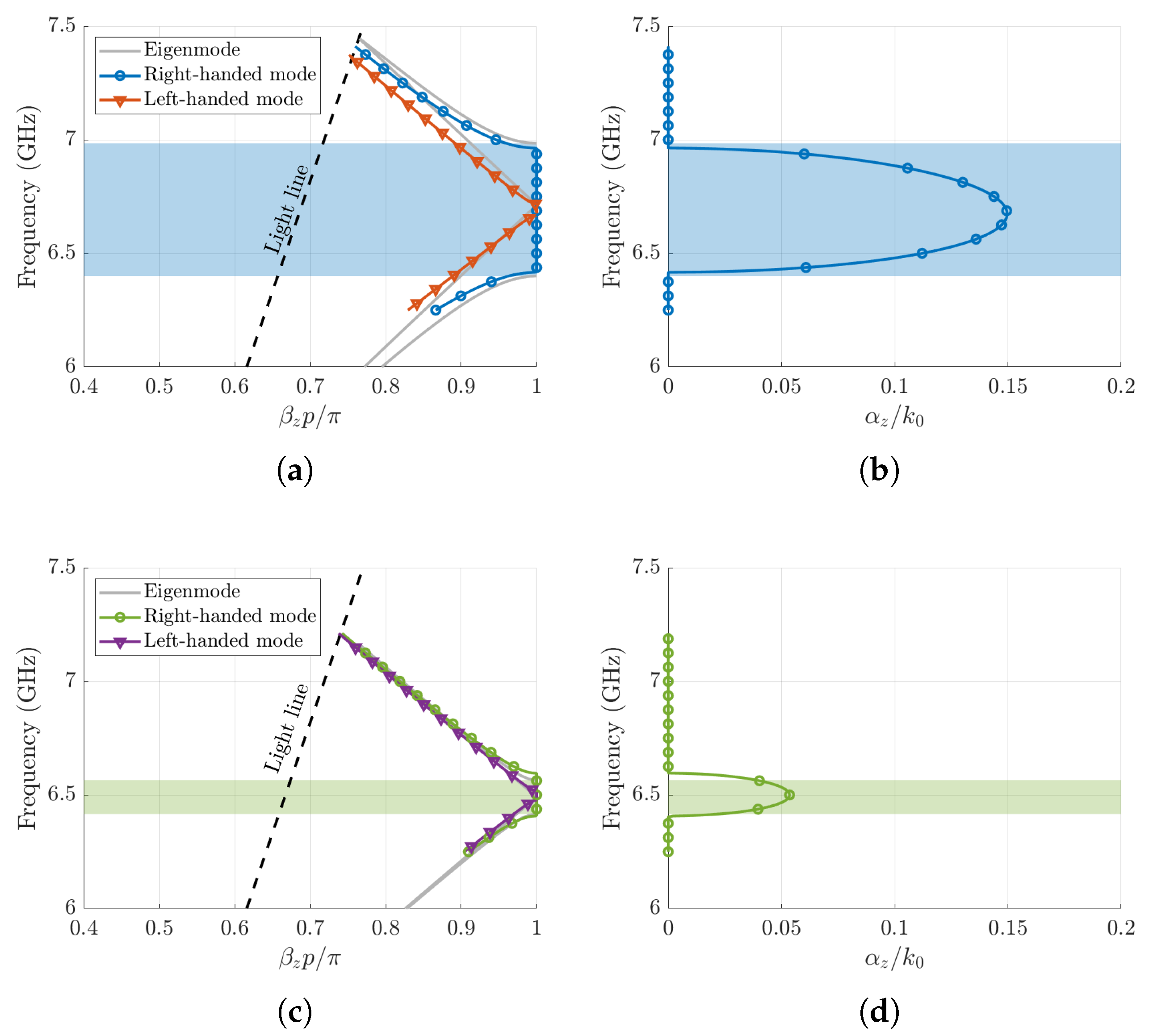

Publisher’s Note: MDPI stays neutral with regard to jurisdictional claims in published maps and institutional affiliations. |
© 2021 by the authors. Licensee MDPI, Basel, Switzerland. This article is an open access article distributed under the terms and conditions of the Creative Commons Attribution (CC BY) license (https://creativecommons.org/licenses/by/4.0/).
Share and Cite
Castillo-Tapia, P.; Van Gassen, K.; Chen, Q.; Mesa, F.; Sipus, Z.; Quevedo-Teruel, O. Dispersion Analysis of Twist-Symmetric Dielectric Waveguides. Photonics 2021, 8, 206. https://doi.org/10.3390/photonics8060206
Castillo-Tapia P, Van Gassen K, Chen Q, Mesa F, Sipus Z, Quevedo-Teruel O. Dispersion Analysis of Twist-Symmetric Dielectric Waveguides. Photonics. 2021; 8(6):206. https://doi.org/10.3390/photonics8060206
Chicago/Turabian StyleCastillo-Tapia, Pilar, Kwinten Van Gassen, Qiao Chen, Francisco Mesa, Zvonimir Sipus, and Oscar Quevedo-Teruel. 2021. "Dispersion Analysis of Twist-Symmetric Dielectric Waveguides" Photonics 8, no. 6: 206. https://doi.org/10.3390/photonics8060206
APA StyleCastillo-Tapia, P., Van Gassen, K., Chen, Q., Mesa, F., Sipus, Z., & Quevedo-Teruel, O. (2021). Dispersion Analysis of Twist-Symmetric Dielectric Waveguides. Photonics, 8(6), 206. https://doi.org/10.3390/photonics8060206






